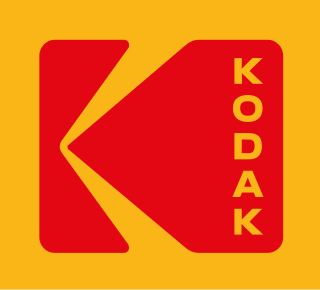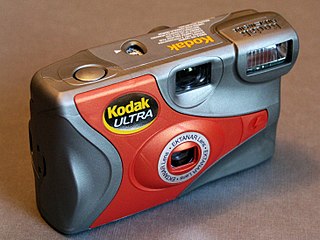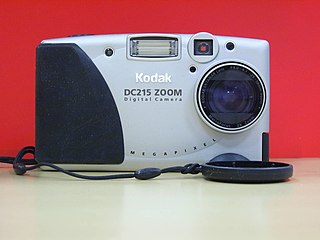
A camera is an instrument used to capture and store images and videos, either digitally via an electronic image sensor, or chemically via a light-sensitive material such as photographic film. As a pivotal technology in the fields of photography and videography, cameras have played a significant role in the progression of visual arts, media, entertainment, surveillance, and scientific research. The invention of the camera dates back to the 19th century and has since evolved with advancements in technology, leading to a vast array of types and models in the 21st century.

The Eastman Kodak Company, referred to simply as Kodak, is an American public company that produces various products related to its historic basis in film photography. The company is headquartered in Rochester, New York, and is incorporated in New Jersey. It is best known for photographic film products, which it brought to a mass market for the first time.

A rangefinder camera is a camera fitted with a rangefinder, typically a split-image rangefinder: a range-finding focusing mechanism allowing the photographer to measure the subject distance and take photographs that are in sharp focus. Most varieties of rangefinder show two images of the same subject, one of which moves when a calibrated wheel is turned; when the two images coincide and fuse into one, the distance can be read off the wheel. Older, non-coupled rangefinder cameras display the focusing distance and require the photographer to transfer the value to the lens focus ring; cameras without built-in rangefinders could have an external rangefinder fitted into the accessory shoe. Earlier cameras of this type had separate viewfinder and rangefinder windows; later the rangefinder was incorporated into the viewfinder. More modern designs have rangefinders coupled to the focusing mechanism so that the lens is focused correctly when the rangefinder images fuse; compare with the focusing screen in non-autofocus SLRs.

A box camera is a simple type of camera, the most common form being a cardboard or plastic box with a lens in one end and film at the other. They were sold in large numbers during the late 19th and early 20th centuries. The lenses are often single element designs meniscus fixed focus lens, or in better quality box cameras a doublet lens with minimal possible adjustments to the aperture or shutter speeds. Because of the inability to adjust focus, the small lens aperture and the low sensitivity of the sensitive materials available, these cameras work best in brightly lit day-lit scenes when the subject is within the hyperfocal distance for the lens and of subjects that move little during the exposure. Eventually, box cameras with photographic flash, shutter and aperture adjustment were introduced, allowing indoor photos.

The Brownie was a series of camera models made by Eastman Kodak and first released in 1900.

A disposable or single-use camera is a simple box camera meant to be used once. Most use fixed-focus lenses. Some are equipped with an integrated flash unit, and there are even waterproof versions for underwater photography. Internally, the cameras use a 135 film or an APS cartridge.
The Instamatic is a series of inexpensive, easy-to-load 126 and 110 cameras made by Kodak beginning in 1963. The Instamatic was immensely successful, introducing a generation to low-cost photography and spawning numerous imitators.

In photography, reversal film or slide film is a type of photographic film that produces a positive image on a transparent base. Instead of negatives and prints, reversal film is processed to produce transparencies or diapositives. Reversal film is produced in various sizes, from 35 mm to roll film to 8×10 inch sheet film.

In infrared photography, the photographic film or image sensor used is sensitive to infrared light. The part of the spectrum used is referred to as near-infrared to distinguish it from far-infrared, which is the domain of thermal imaging. Wavelengths used for photography range from about 700 nm to about 900 nm. Film is usually sensitive to visible light too, so an infrared-passing filter is used; this lets infrared (IR) light pass through to the camera, but blocks all or most of the visible light spectrum.

A digital single-lens reflex camera is a digital camera that combines the optics and the mechanisms of a single-lens reflex camera with a solid-state image sensor and digitally records the images from the sensor.

Kodak EasyShare was a sub-brand of Eastman Kodak Company products identifying a consumer photography system of digital cameras, snapshot thermal printers, snapshot thermal printer docks, all-in-one inkjet printers, accessories, camera docks, software, and online print services. The brand was introduced in 2001, and discontinued in 2012, when Kodak stopped manufacturing and selling all digital cameras and photo frames.

The Kodak DCS 300 series comprises two cameras, the DCS 315 and DCS 330. They are professional-level digital SLR cameras built by Eastman Kodak's Kodak Professional Imaging Solutions division. They were based on the Nikon Pronea 6i APS SLR camera and were aimed at a lower price point than other models in the Kodak DCS range. The 1.5 megapixel DCS 315 was launched in 1998, while the 3 megapixel DCS 330 was launched in 1999. The DCS 315 was the first digital SLR camera to incorporate an image preview LCD and inbuilt JPEG processing.

The history of the camera began even before the introduction of photography. Cameras evolved from the camera obscura through many generations of photographic technology – daguerreotypes, calotypes, dry plates, film – to the modern day with digital cameras and camera phones.
The Kodak EasyShare V570 was a 5-megapixel digital camera manufactured by Eastman Kodak. Announced on January 2, 2006, it was an upper-end model in the consumer price range, advertised at $400 in the United States in January 2006. It had an innovative dual lens system, combining two periscopic groups each with its own sensor: one very wide angle equivalent to a 23 mm in 135 format and a 3X zoom equivalent to a 39–117 mm, totalizing a virtual 5X zoom, with a step between 23 and 39 mm. It is the first dual lens digital camera. The model won a gold medal in the 2006 Industrial Design Excellence Awards.

The EOS-1N is a 35mm single lens reflex (SLR) camera body produced by Canon. It was announced by Canon in 1994, and was the professional model in the range, superseding the original Canon EOS-1. The camera was itself superseded by the EOS-1v in 2000.

The Kodak DC215 is a discontinued model of digital camera produced in Japan by the Eastman Kodak Company. This model does not have internal memory, but a 4MB card is supplied with the camera. The camera has a 1-megapixel sensor, a fixed focus lens with 2x optical zoom and macro-setting and a built-in flash. The viewfinder is optical, but it is possible to use the 1.8" rear LCD monitor as viewfinder, though Kodak did not recommend that due to high battery consumption. There was also a small LCD black and white screen on the top of the camera to show camera settings only. The DC215 also came in a "Millennium Edition" version which had a gold rather than silver case and came with some additional accessories.

The Kodak Retina Reflex is a discontinued series of four single-lens reflex cameras made by Kodak in Germany between 1957 and 1974, as part of the Kodak Retina line of 35mm film cameras.
The Canon EOS DCS 1 was Kodak's third Canon-based Digital SLR camera. It was released in December 1995, following the cheaper EOS DCS 3, which was released earlier that year. Like that camera, it combined an EOS-1N body with a modified Kodak DCS 460 digital back. Despite offering a then-enormous resolution of 6 megapixels with a relatively large APS-H sensor, a number of technical issues meant that it was never a very popular camera other than for a few people with specialized roles.

The Kodak DC series was Kodak's pioneering consumer-grade line of digital cameras; as distinct from their much more expensive professional Kodak DCS series. Cameras in the DC series were manufactured and sold during the mid-to-late 1990s and early 2000s. Some were branded as "Digital Science". Most of these early digital cameras supported RS-232 serial port connections because USB hardware was not widely available before 1998. Some models in the DC series ran on the short lived DigitaOS, a camera operating system that allowed third party software to be installed.

The Apple QuickTake is one of the first consumer digital camera lines. It was launched in 1994 by Apple Computer and was marketed for three years before being discontinued in 1997. Three models of the product were built including the 100 and 150, both built by Chinon; and the 200, built by Fujifilm. The QuickTake cameras had a resolution of 640 x 480 pixels maximum.

















